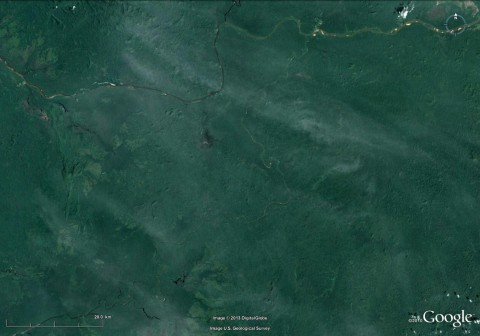Seit einiger Zeit versuche ich mich wieder an „Where on Google Earth“, allerdings bis jetzt wenig erfolgreich. (Um was es bei Where on Google Earth geht, steht weiter unten. Vergangene WoGEs sammelt Felix Bossert auf seinem Blog und in einer KML-Datei.) Nun hatte ich, zusammen mit meinem guten Freund Frank (im WoGE-Archaikum schon einmal als „pl“ in Erscheinung getreten), das letzte WoGE von Ole Tjugen relativ flott gefunden und geologisch interpretiert. (An letzterem hatte es beim WoGE #378 gehapert.) Zwei Salzgletscher im südlichen Iran – ein sehr interessantes und mir vorher völlig unbekanntes Phänomen.
Jetzt darf ich mir also das nächste Rätsel ausdenken. Ich hoffe, es ist halbwegs einfach, damit auch Neueinsteiger eine Chance haben. (Schotts Regel gilt, s.u.)
Für diejenigen, die neu bei Where on (Google) Earth sind: einfach einen Kommentar mit geographischer Länge und Breite (oder eine Ortsbezeichnung) hinterlassen und darin etwas über die (geologischen/geographischen/hydrographischen) Besonderheiten in diesem Bild schreiben. Der Gewinner darf dann das neue WoGE ausrichten.
In den Kommentaren bitte möglichst englisch schreiben.
Weil dieses Rätsel (vermutlich) eher einfach ist, gilt Schotts Regel: frühere Gewinner müssen für jedes WoGE, das sie erraten haben, 1 Stunde mit der Antwort warten. Ich werde ein paar Hinweise geben, wenn nach einiger Zeit keine Antwort kommt.
Veröffentlicht am 31.05.13, 16:00 MESZ (14:00 UTC).
Viel Spaß und Erfolg!


Kommentare (3)
Finding an area this large with so few visible features was quite a feat. By adjusting the contrast a lot, I managed to find out that it was probably on the northern hemisphere, which let me start searching South America from the north. It still took a while before I found
3°N, 66°W - which should be precision enough for this overview.
Finding out what it IS took longer. Finally I spotted a tiny little Wikipedia tag. 🙂
"The Casiquiare river is a distributary of the upper Orinoco flowing southward into the Rio Negro, in Venezuela, South America. As such, it forms a unique natural canal between the Orinoco and Amazon river systems. It is the largest river on the planet that links two major river systems, a so-called bifurcation. The area forms a water divide, more dramatically at regional flood stage."
http://en.wikipedia.org/wiki/Casiquiare_canal
I thought finding an featureless area this large would be easier than finding a small one. 😉
But seriously – the big clue in my opinion was the hydrography. (I even changed my boilerplate text below the image accordingly. *g*) In the southwest corner (near the scale bar), tributaries joining the river running through the centre (the Casiquiare) suggest a flow direction to the SW. Similarily, at the western border tributaries to the E-W river (Orinoco) indicate flow to the west. This is further corroborated by the water colours: in the east of the Orinoco the water is light brown; the tributary from N is dark; in the west, the Orinoco is medium brown, showing that this is the continuation.
So there are diverging flow directions, i.e. a bifurcation. Given the small scale of the image and the absence of large human activities, this must be a big, natural bifurcation. There are not many of these.
(A further hint may be the same colour of water in the eastern Orinoco and the Casaquiare.)
Again, this shows different approaches different people follow and what they judge “easy”.
http://overburdenblog.blogspot.no/2013/06/where-on-google-earth-382.html is up.
One of my candidates for this WoGE involved a river running backwards through its valley, which might be a reason why I tend to distrust the obvious flow directions. So this time there are no rivers. 😀
Kommentar schreiben